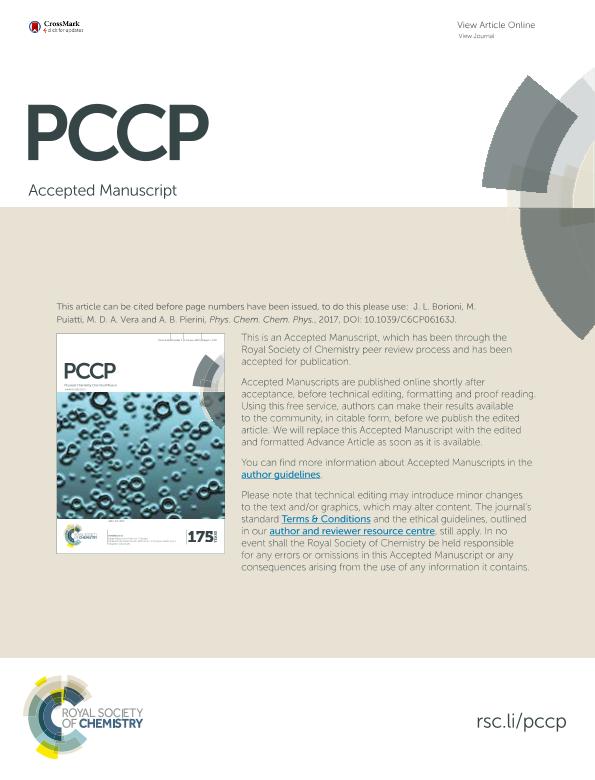Mostrar el registro sencillo del ítem
dc.contributor.author
Borioni, José Luis

dc.contributor.author
Puiatti, Marcelo

dc.contributor.author
Vera, Domingo Mariano Adolfo

dc.contributor.author
Pierini, Adriana Beatriz

dc.date.available
2018-04-05T13:55:44Z
dc.date.issued
2017-01
dc.identifier.citation
Borioni, José Luis; Puiatti, Marcelo; Vera, Domingo Mariano Adolfo; Pierini, Adriana Beatriz; In search of the best DFT functional for dealing wi th organic anionic species ; Royal Society of Chemistry; Physical Chemistry Chemical Physics; 19; 13; 1-2017; 9189-9198
dc.identifier.issn
1463-9076
dc.identifier.uri
http://hdl.handle.net/11336/40814
dc.description.abstract
Quantum chemical computational methods are thought to have problems in dealing with unstable organic anions. This work assesses the ability of different Density Functional Theory (DFT) functionals to reproduce the electron affinity and reduction potential of organic compounds. The performance of 23 DFT functionals was evaluated by computing the negative electron affinities (from 0 eV to −3.0 eV) and reduction potentials in acetonitrile (from 0 to −2.7 V). In general, most of the hybrid GGA functionals work fine in the prediction of electron affinities, BPW91, B3PW91 and M06 being the best in each class of functionals (pure, hybrid and meta-GGA functionals, respectively). On the other hand, the ab initio post-Hartree–Fock methods, MP2 and coupled-cluster (CCSD(T)), as well as the double hybrid functionals, B2PLYP and mPW2PLYP, usually fail. For compounds with EAs lower than −1.75 eV, a method for stabilizing the anion, based on solvation with the IEFPCM model, was employed. In this case, BPW91, PBE0 and M06-HF could be the recommended option for the pure, hybrid and meta-GGA functionals, respectively. The situation improves for the evaluation and prediction of redox potentials. In this case the performance of the DFT functionals is better, in part because the solvent assists in the stabilization of the anions. Nevertheless, there is a systematic bias in the calculation of absolute redox potentials, which could be corrected by using a redox partner that helps by the cancellation of errors. In this case, the hybrid and meta-GGA functionals B3PW91, PBE0, TPSSh and M06 are also among the best for computing redox potentials with a mean absolute deviation (MAD) lower than 0.13 V.
dc.format
application/pdf
dc.language.iso
eng
dc.publisher
Royal Society of Chemistry

dc.rights
info:eu-repo/semantics/openAccess
dc.rights.uri
https://creativecommons.org/licenses/by-nc-sa/2.5/ar/
dc.subject
Dft
dc.subject
Coupled Clusters
dc.subject
Radical Anions
dc.subject
Negative Electron Affinities
dc.subject
Temporary Anions
dc.subject
Valence Anions
dc.subject
Non-Valence Anions
dc.subject
Reduction Potentials
dc.subject
Single Electron Transfer (Set)
dc.subject
Corrected Functionals
dc.subject.classification
Otras Ciencias Químicas

dc.subject.classification
Ciencias Químicas

dc.subject.classification
CIENCIAS NATURALES Y EXACTAS

dc.title
In search of the best DFT functional for dealing wi th organic anionic species
dc.type
info:eu-repo/semantics/article
dc.type
info:ar-repo/semantics/artículo
dc.type
info:eu-repo/semantics/publishedVersion
dc.date.updated
2018-04-03T18:43:05Z
dc.journal.volume
19
dc.journal.number
13
dc.journal.pagination
9189-9198
dc.journal.pais
Reino Unido

dc.description.fil
Fil: Borioni, José Luis. Consejo Nacional de Investigaciones Científicas y Técnicas. Centro Científico Tecnológico Conicet - Córdoba. Instituto de Investigaciones en Físico-química de Córdoba. Universidad Nacional de Córdoba. Facultad de Ciencias Químicas. Instituto de Investigaciones en Físico-química de Córdoba; Argentina
dc.description.fil
Fil: Puiatti, Marcelo. Consejo Nacional de Investigaciones Científicas y Técnicas. Centro Científico Tecnológico Conicet - Córdoba. Instituto de Investigaciones en Físico-química de Córdoba. Universidad Nacional de Córdoba. Facultad de Ciencias Químicas. Instituto de Investigaciones en Físico-química de Córdoba; Argentina
dc.description.fil
Fil: Vera, Domingo Mariano Adolfo. Consejo Nacional de Investigaciones Científicas y Técnicas. Centro Científico Tecnológico Conicet - Mar del Plata. Instituto de Investigaciones en Biodiversidad y Biotecnología; Argentina
dc.description.fil
Fil: Pierini, Adriana Beatriz. Consejo Nacional de Investigaciones Científicas y Técnicas. Centro Científico Tecnológico Conicet - Córdoba. Instituto de Investigaciones en Físico-química de Córdoba. Universidad Nacional de Córdoba. Facultad de Ciencias Químicas. Instituto de Investigaciones en Físico-química de Córdoba; Argentina
dc.journal.title
Physical Chemistry Chemical Physics

dc.relation.alternativeid
info:eu-repo/semantics/altIdentifier/doi/http://dx.doi.org/10.1039/c6cp06163j
dc.relation.alternativeid
info:eu-repo/semantics/altIdentifier/url/http://pubs.rsc.org/en/Content/ArticleLanding/2017/CP/C6CP06163J
Archivos asociados
